Decolonising the Classroom
Current teaching methods in many nations across the globe tend to stem from Eurocentric traditions, which can be at odds with the communities and experiences of the students and teachers involved. Based at the University of Saskatchewan in Canada, Dr Geraldine Balzer is advocating the introduction of alternative methods and materials that give a broader worldview. These can support the deconstruction of the systemic ills of colonialism, helping upcoming generations to appreciate diversity and address injustices.
Glossary
BIPOC — Black, Indigenous and people of colour
Canon — a collection of books treated as the genuine ‘truth’ (originally in religious contexts)
Cognitive dissonance — the perception of contradictory information and the effect this has on the mind
Colonisation — the settling among, and establishing control over, Indigenous Peoples and their lands
Critical literacy — the ability to find embedded discrimination or prejudice in media
Decolonisation — the process of freeing a system or institution from the effects of colonisation
Eurocentric — a tendency to interpret the world in terms of European values and experiences
Indigenous — inhabiting a land since before the time of colonisation
Marginalisation — treatment of a social group or person as unimportant or without power
Patriarchal — describing a society or system controlled by men
Pedagogy — the method and practice of teaching
Socratic circle — a method for facilitating student discussion, where students sit in a circle, facing each other
Trope — a recurring metaphor or symbol
A key aspect of colonialism involves taking the values and practices of the colonisers’ culture and imposing them on those of the colonised. This inevitably leads to inequities. As well as introducing systems that can run counter to the needs and experiences of the colonised, it also establishes a power structure with the colonisers at the top. Colonialism continues to cast a shadow over many nations of the world, perpetuating injustices. At the University of Saskatchewan, Dr Geraldine Balzer is working to address these injustices through one particularly powerful tool: teaching.
“Current and traditional pedagogies grow out of Eurocentric educational traditions,” says Geraldine. “In the Canadian context, these evolved from the British and American educational systems.” Such systems prioritised literature from their respective traditions, which were principally authored by white men from wealthier backgrounds. “This set of literature became known as the school canon,” says Geraldine. “The school canon validates specific ways of existing in the world, centres on white middle- and upper-class values, and normalises a hierarchical, patriarchal structure.”
Impacts
The use of the school canon when teaching literature leaves many students feeling their own experiences are going unrecognised. “The most significant impact for students is that they do not see themselves represented in these texts,” says Geraldine. “In the school canon, the central characters are usually white and male. Any other characters are rarely in positions of power or autonomy.” For instance, female characters are typically secondary, fulfilling traditional roles such as caregivers, while BIPOC characters are often in subservient roles. “If racism is ever confronted, such as in texts like To Kill a Mockingbird by Harper Lee, the white saviour trope emerges,” explains Geraldine. “Any stories of marginalised individuals are typically through the lens of trauma, with these individuals in the role of victim.”
The establishment of these roles within literature implies that these are the only roles that do and ‘should’ exist in the real world, cementing perceptions of existing power hierarchies as the right and proper way of doing things. This has effects at the personal level. “If learners only see themselves represented in these traditional roles, it is difficult to imagine themselves in other roles,” says Geraldine. “It is not only students, but also women or BIPOC teachers that can also feel marginalised by the school canon.”
Ongoing injustices of colonialism
The far-reaching impacts of colonialism persist to this day all around the world. “We can see the ongoing effects of colonialism in low access to education for women in Afghanistan and Iran, the lack of voice for Indigenous Peoples in Australia, and the ongoing Israel-Palestine conflict, to name a few,” says Geraldine. Canada’s colonial past also continues to hold a heavy influence over how the country operates, despite an ever-evolving demographic. “Mobility and immigration mean that the diversity in our classrooms is changing constantly,” says Geraldine. “History teaching has emphasised the immigration of Europeans to Canada, but little attention has been given to the influx of immigrants from Asia, or to Canada’s historic Black communities.”
While Canada promotes itself as highly multicultural, this does not address the unequal power structures that continue to exist and support Eurocentric values. This is why active decolonisation efforts are needed. “Decolonisation exposes these power structures, examining the roots of discrimination and oppression with the goal of building a more equitable society,” says Geraldine. “In the classroom, decolonising pedagogies provide paths for teachers to introduce multiple perspectives to their students, support their discussions of access to power, and illustrate the ways that oppressive structures persist.”
Barriers
However, the introduction of such pedagogies comes up against some significant challenges. Current constructs are well-established, making change difficult, and this applies to schools as much as any aspect of society. Schools typically follow a rigid curriculum, promote teachers as a source of invulnerable authority, and even keep classroom layouts restrictive. “School architecture is part of this colonising process, as the physical structures constrain the kinds of activities that teachers can implement,” explains Geraldine. “For instance, small group discussions such as Socratic circles are difficult to organise in spaces with individual desks.”
Furthermore, noisy classrooms – which are inevitable when multiple learning-based discussions are taking place – are typically frowned upon. Pressures on time and resources, as well as the school’s own culture and lack of support for new approaches, can often act as barriers to moving away from the school canon. “Teachers are discouraged from trying new things if they are not validated in their efforts,” says Geraldine. “Additionally, accessing the budget necessary to purchase new resources can be a major barrier.”
Teacher inquiry groups
Reference
https://doi.org/10.33424/FUTURUM470
With these barriers in mind, Geraldine has been working collaboratively to bring alternative pedagogies into classrooms. She ran a multi-year research project (one of eight such projects that took place across Canada), working with a group of teachers to understand their experiences and to support their efforts to introduce alternative pedagogies into the classroom. “We met regularly to discuss strategies of literature, beginning with postcolonial theory and the necessity of discomfort,” says Geraldine. “We discussed how literature needs to represent the people within our classrooms and to tell stories that counter traditional narratives.” The project provided the funds needed to purchase sets of classroom books, including titles suggested by the teachers, creating a ‘library’ that the teachers could borrow from.
As the project progressed, discussions turned from theory and literature towards pedagogical strategies, students’ responses to the literature, and teachers’ own personal development. “The inquiry group was a place to test ideas among colleagues who had become friends,” explains Geraldine. “Some of us developed a workshop for the European Literary congress in Spain, and others attended a final symposium of the larger research group from all eight sites.” This symposium offered the opportunities to share experiences and successes, exchange recommendations for literature, and celebrate the research journey. Geraldine went on to co-author a book chapter with some of the teacher participants.
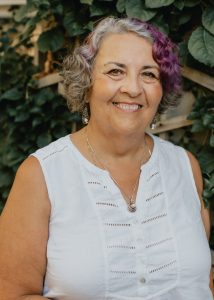 Dr Geraldine Balzer
Dr Geraldine Balzer
Department of Curriculum Studies, College of Education, University of Saskatchewan, Canada
Fields of research: Social justice teaching, decolonisation, reciprocity
Research project: Collaboratively developing a social justice pedagogy that aims to deliver inclusive, decolonised teaching methods and materials
Funder: Social Sciences and Humanities Research Council of Canada (SSHRC)
Indigenous communities
Geraldine’s project involved working with people from a wealth of backgrounds, including Indigenous Peoples. One school served a significant Indigenous population, in a community adjacent to First Nation reserves. Prior to this research project, Geraldine has a long history of research with Indigenous communities. “Since 2007, I have worked with Indigenous communities in Guatemala,” she says. “During that time, the focus of my research shifted from examining how the worldviews of Canadian youths changed following learning opportunities in Guatemala, to how these study tours impacted host communities.”
Geraldine’s findings were profound: the communities perceived these learning efforts as another extractive industry, one where researchers gained information for their own purposes, but the community saw little benefit. “We have been trying to change this by engaging members of the local community in the development of the research project itself, including the gathering of data along with analysis and validation,” says Geraldine. “Our aim is to develop an ethic of reciprocity focused on co-creation of knowledge.”
Key findings
Teachers reported students responded positively to the selection of postcolonial literature that they were presented with. “For instance, through reading texts by Afghan author Khaled Hosseini, students were able to see Afghans as people they could relate to – they were no longer ‘the other’,” says Geraldine. “When reading the memoir of Ishmael Beah, including recounts of his time as a child soldier in the Sierra Leone Civil War, students responded with frustration at not having known this event had happened.” Such conversations led to analysis of Canadian news and media, including which global events received airtime and which were rarely mentioned, and how these choices related to political power structures.
Other texts covered experiences closer to home. “Students also read texts by Canadian Indigenous writers, empowering Indigenous students to speak up about their experiences and express pride in who they are,” says Geraldine. “These pieces of literature provided counter stories to dominant narratives, ensuring the voices of diverse members of the community are heard and that unfair power dynamics are exposed.”
Facilitating discussions
Making these discussions happen is not as simple as just giving the students different books to read; it also involves changing the structure of lessons. “First, a culture of respect needs to be established where all voices are valued and questions can be asked without judgement,” says Geraldine. “This involves teachers being models for questioning and curiosity, and admitting their own lack of knowledge.” This introduces a degree of vulnerability for teachers, but this can bring its own benefits through empowering students to feel their voice is equal to that of the teacher. Geraldine’s group often changed the layout of the classroom itself. “A non-hierarchical form like sitting in a circle, or even removing desks altogether, can help shift power structures,” says Geraldine. “Many teachers use an Indigenous talking circle, to ensure that students can express their opinions without being interrupted.
This involves an object such as a stick or rock being passed around, with only the holder of the object permitted to speak.”
Teachers also help coach students in how to use language to present possibly controversial opinions in non-confrontational ways, which can be a powerful skill for facilitating change. All these efforts help build trust among students and with the teacher, which, with time, can help students to speak up, challenge ideas of the status quo, and point out fallacies in societal assumptions. “Such methods help combat racism and other oppressive structures through gentle and inclusive means,” says Geraldine. “They enable students to become, as author bell hooks would say, ‘enlightened witnesses’ of the world.”
Critical literacy
Every piece of literature has a social context, and understanding these contexts is a necessary part of appreciating the viewpoint of the author and how it fits into the wider system and the injustices held within. “Critical literacy helps students to understand that texts, and our interpretations of these texts, are always socially constructed,” says Geraldine. “They are never neutral.” Learnings in how to spot these social constructs in texts can be readily applied to the real world. After all, social constructs are at the heart of the power structures that govern our society.
Rather than directly challenging students’ own beliefs or backgrounds, which could be a deeply uncomfortable and potentially counterproductive experience, literature provides an avenue more removed from the individual. “Literature is a safe path into these conversations because it doesn’t begin by examining students’ own social contexts, but lets them see these structures through stories and make the links to their own lived experience themselves,” says Geraldine. “Exposure to different perspectives enables them to make connections to issues close to home and ask hard questions about the structure of their own community, media coverage of events, and advertising tactics.” Such critical analysis inevitably leads to the recognition of systemic inequities – and recognition is the first step towards tackling them.
Displacement of power
Overhauling teaching techniques and texts can take students and teachers alike out of their comfort zone – but this is not a bad thing. “Change is usually precipitated by discomfort, so a pedagogy of discomfort brings about change,” says Geraldine. “The trick is finding the level of discomfort that creates the cognitive dissonance needed to affect change, without causing so much discomfort that people resist and double down on their held beliefs.” Geraldine refers to Megan Boler’s ‘pedagogy of discomfort’, which involves students critically examining their own ideological assumptions – an uncomfortable but rewarding task, which can also be valuable for personal development.
Being able to identify power imbalances and their colonial origins can help people advocate for directed change. “Colonised people have been constructed as inferior to colonisers, and this power imbalance fosters classism and racism that perpetuate societal inequities,” explains Geraldine. “Decolonising pedagogies expose the roots of these imbalances and reveal how language can be used to perpetuate these systems.”
Teachers as advocates for social justice
Adolescents are still making sense of the world, forming worldviews that will become more cemented and difficult to challenge later in life. This means that teachers have an important role to play in guiding the perceptions of upcoming generations, which will inform the decisions they make throughout their lives and careers. “Most adolescents are looking for things that aren’t fair, so helping them understand the context of injustices in their communities is a good place to begin,” says Geraldine. “Teachers can look for places where injustice prevails and draw their students’ attention to it.”
Once students are aware of these injustices, the next step is to give them the tools to address them. “While solving global problems such as the refugee crisis is out of reach, there are often opportunities for students to champion justice within their own communities,” says Geraldine. “For instance, advocating for women in student governance, or making playgrounds more accessible may be goals that are possible for students to achieve.” This encapsulates the ‘think global, act local’ mantra that informs advocacy work around the world. “Most importantly, teachers need to be models for enabling change,” says Geraldine. “Being an advocate of social justice necessarily involves strategies to make the world a more just place.”
Do you have a question for Geraldine?
Write it in the comments box below and Geraldine will get back to you. (Remember, researchers are very busy people, so you may have to wait a few days.)
1 Comment
Submit a Comment
Learn more about how Indigenous knowledge can enrich education:

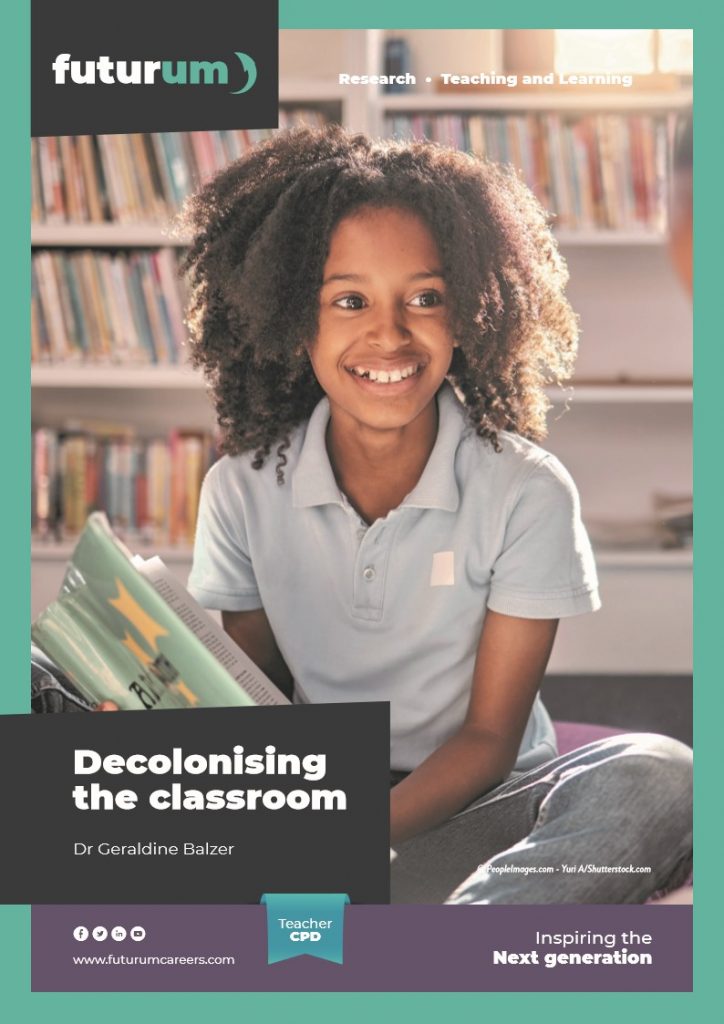
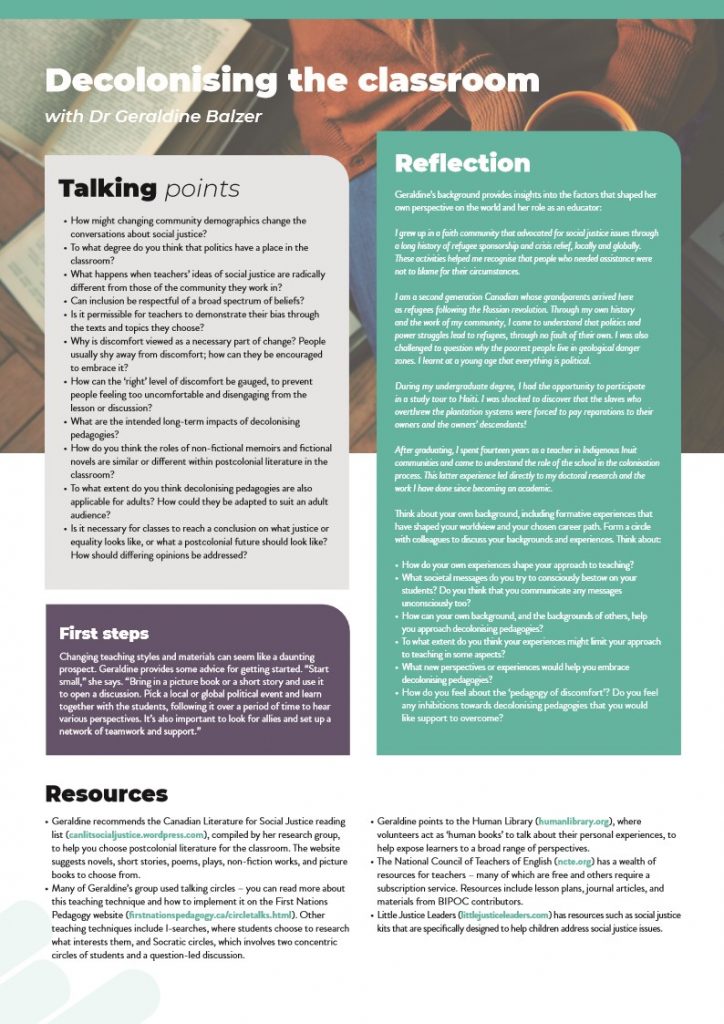
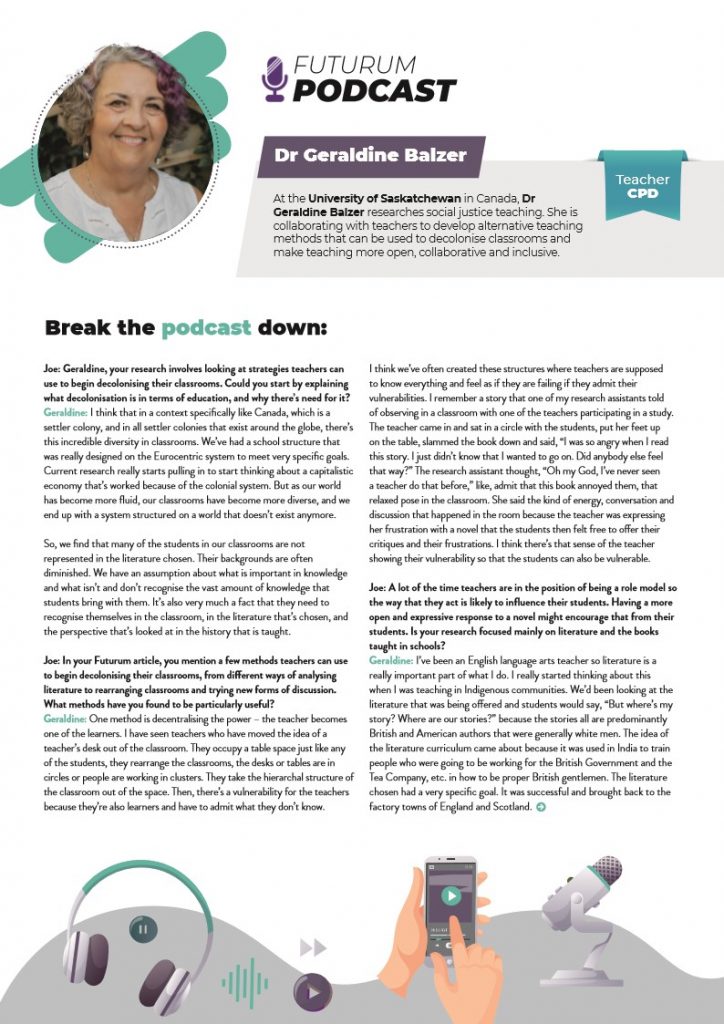
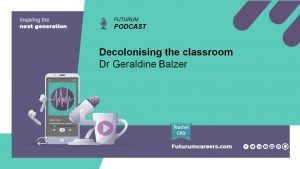
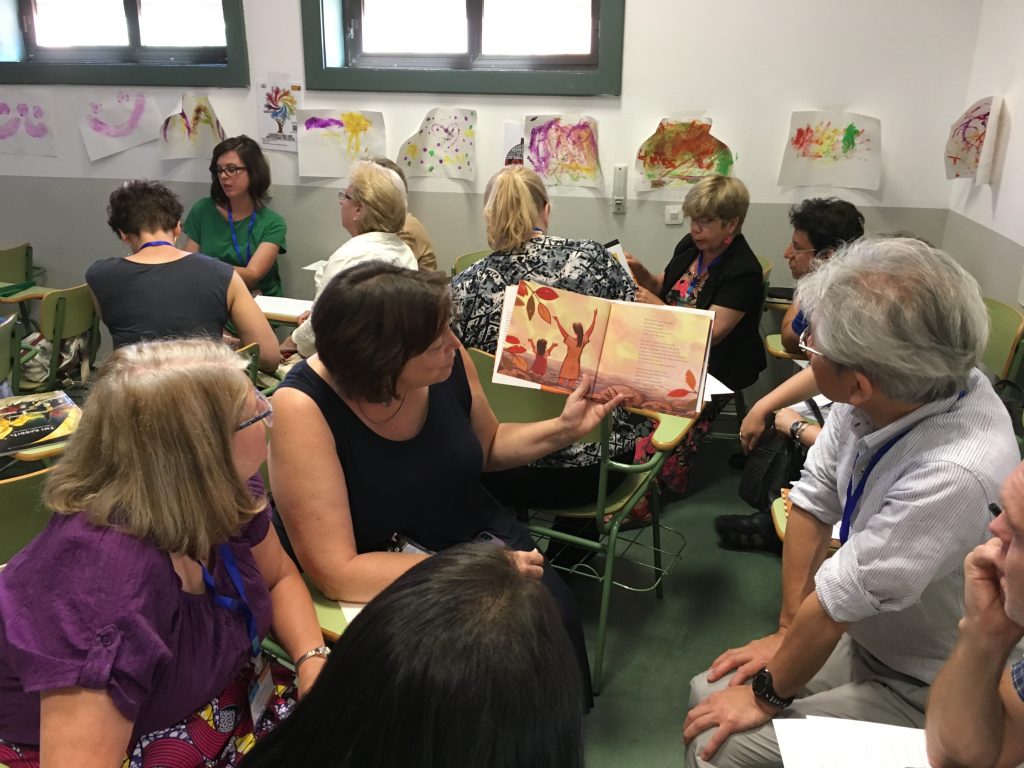


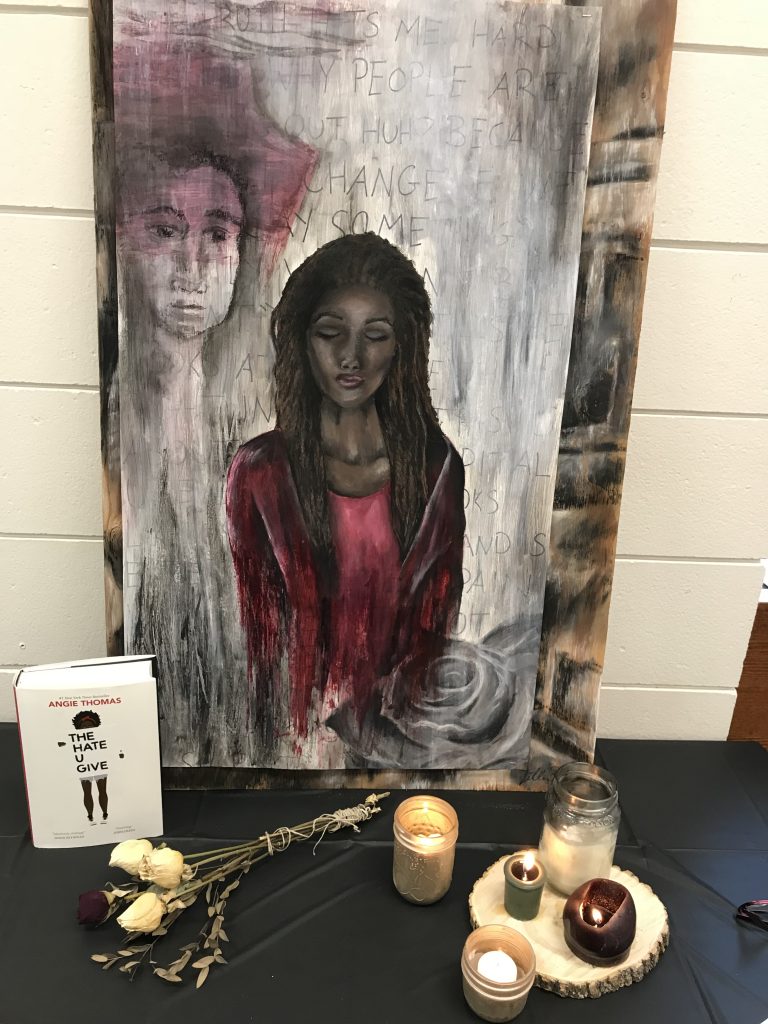

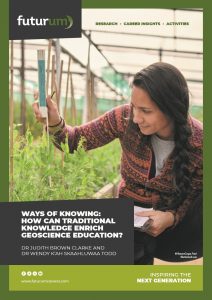
hey Geraldine
my name is georgia i am from the UK and im doing a prject on how we can diversify creative subjects and encourage more people of colour to partake in creative subjects like art, design, music creative writing etc. I am half indian and half english and i found the uk has a very eurcentric way of teaching. when i was studying art in school i only found artists of colour through my own research. all the artissts students are taught about come from white backgrounds which i feel like you have written can make people of colour feel as though it is not a place for them as they lack represenation.additionally alot of asian families encourage thier children to take “better paying” career paths – i am the only person in the indian side taking graphic design at university , they all do medicine or law.
there are spaces in higher education specifially for Black creatives but what about asians too? also i feel if it was integrated into the education system there wouldn’t be a need for specific spaces which feels more segerating than unifying i dont know if that makes sense but that’s how i feel? i would love to hear any helpful insights you may have on how i can go about this predicament and what your thoughts are. i’m sure you’re very busy but i’d love to arrange an interview if you can it would be online.. but yeah would be awesome to hear your thoughts and further experiences
best wishes
Georgia Papworth